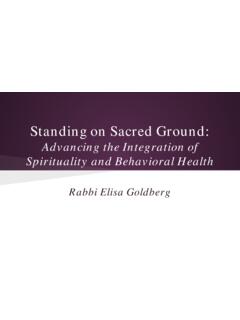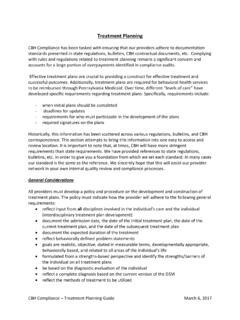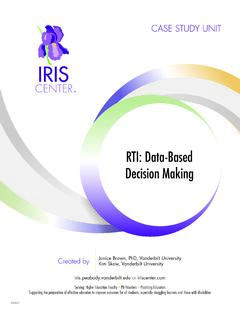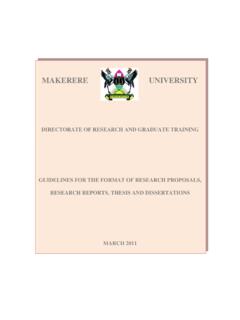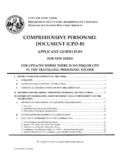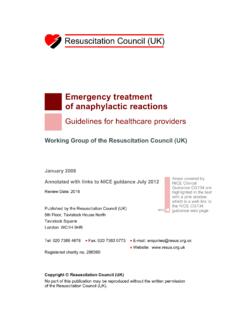Transcription of Clinical Guidelines for the Prescribing and Monitoring of ...
1 Clinical Guidelines for the Prescribing and Monitoring of Benzodiazepines and Related Medications Introduction Prescriptions for benzodiazepine medications (primarily for anxiety or insomnia) filled in the United States increased by 320% from 1996-2013. Over this same interval, overdose deaths associated with these medications increased over 500%.1 A portion of this increase in mortality is likely attributable to the higher dose per prescription observed, as well as the marked increase of opioid Prescribing over this same period. The role of benzodiazepines in opioid overdose deaths nationwide increased from 18% of opioid overdose deaths in 2004 to 31% in In Philadelphia, the issue is even more remarkable, with a 2016 report finding that approximately 90% of all opioid overdose death also involved While there are a number of legitimate uses for benzodiazepines and related medications, there is not yet a clear consensus as to how best to conceptualize their role in the pharmacotherapy of psychiatric disorders.
2 This is particularly clear in Philadelphia, where the variation in benzodiazepine Prescribing rates is remarkably high. CBH seeks to promote practices to maximize access to evidence-based practices for individuals seeking treatment for anxiety and insomnia. This is best accomplished by limiting the initiation of benzodiazepines when more effective or safer options are readily available, given the high liability for these medications to complicate recovery from substance use disorders, or lead to iatrogenic . benzodiazepine dependence. Tapering and discontining these medications once dependence has formed is very difficult. These Guidelines should be understood to apply to benzodiazepine receptor agonists ( zolpidem), in the case of sleep, as well as to barbiturates, and other less-commonly prescribed, controlled sedative-hypnotics, where even greater risks may exist.
3 1 Bachhuber et al., Increasing Benzodiazepine Prescriptions and Overdose Mortality in the United States, 1996 2013. Am J. Public Health. Published online ahead of print February 18, 2016: e1 e3. 2 Jones CM, McAninch JK. Emergency department visits and overdose deaths from combined use of opioids and benzodiazepines. Am J Prev Med. 2015;49(4): 493 501. 3 Philadelphia Department of Public Health. Overdose deaths involving opioids in Philadelphia. CHART 2016;1(1):1-8. Clinical Guidelines for the Prescribing and Monitoring of Benzodiazepines and Related Medications 1. July 30, 2018. Standard 1: Benzodiazepines should not be initiated as monotherapy for the treatment of anxiety disorders.
4 While there is evidence that benzodiazepines can be used safely and effectively for the treatment of anxiety, evidence-based Guidelines recommend their reservation as second-line 5 Other pharmacologic treatments, primarily serotonin-norepinephrine reuptake inhibitors (SNRI) and selective serotonin reuptake inhibitors (SSRI) have the benefit of a much stronger base of Clinical trial evidence to support as first-line use and have significant safety advantages. Nonpharmacologic treatments may also be considered as first-line treatments for multiple anxiety disorders; those focusing on cognitive- behavioral and exposure-based models have the strongest supporting evidence.
5 Exception: Treatment should be individualized when possible to help support individuals' recovery goals. When there is documented intolerance or poor response to first-line treatments for anxiety disorders (see figure below), then benzodiazepine monotherapy may be appropriate. First-line Pharmacologic Therapy for Anxiety Disorders Panic Disorder Generalized Social Anxiety Obsessive Post- Anxiety Disorder Compulsive traumatic Disorder Disorder Stress Disorder Selective Serotonin Reuptake Inhibitors (SSRI). Citalopram X. Escitalopram X X X X. Fluoxetine X X X. Fluvoxamine X X X. Paroxetine X X X X X. Sertraline X X X X X. Serotonin-Norepinephrine Reuptake Inhibitors (SNRI).
6 Venlafaxine X X X X. Duloxetine X. Adapted from Bandelow et al., 2012. First-line here refers to medications supported fully by Clinical trial evidence and that gave a good risk/benefit ratio. Discussion of methods for grading of evidence and risk/benefit discussed more fully in Bandelow et al., 2008. 4 Katzman MA, Bleau P, Blier P, Chokka P, Kjernisted K, Van Ameringen M; Canadian Anxiety Guidelines Initiative Group on behalf of the Anxiety Disorders Association of Canada/Association Canadienne des troubles anxieux and McGill University, Antony MM, Bouchard S, Brunet A, Flament M, Grigoriadis S, Mendlowitz S, O'Connor K, Rabheru K, Richter PM, Robichaud M, Walker JR.
7 Canadian Clinical practice Guidelines for the management of anxiety, posttraumatic stress and obsessive-compulsive Psychiatry. 2014;14 Suppl 1:S1. doi: Epub 2014 Jul 2. 5 Borwin Bandelow , Leo Sher, Robertas Bunevicius , Eric Hollander, Siegfried Kasper, Joseph Zohar, Hans-J rgen M ller 6, WFSBP Task Force On Mental Disorders In Primary Care and WFSBP Task Force on Anxiety Disorders , OCD and PTSD. Clinical Guidelines for the Prescribing and Monitoring of Benzodiazepines and Related Medications 2. July 30, 2018. Standard 2: Benzodiazepines should not be used for the treatment of insomnia without appropriate evaluation, and should not be used chronically.
8 Prior to the initiation of benzodiazepines or benzodiazepine receptor agonist medications, a thorough evaluation for underlying causes of secondary insomnia should be performed and This evaluation should screen for sleep-related breathing disorders ( obstructive sleep apnea), sleep- related movement disorders ( restless legs syndrome), adverse medication or caffeine effects, behavioral causes ( poor sleep hygiene), and psychiatric syndromes known to cause insomnia. Individuals should also be screened for other contraindications discussed in these Guidelines . When benzodiazepines are used for the treatment of insomnia, an initial treatment period of 2-4 weeks is recommended, as many individuals will remain asymptomatic after tapering at this point.
9 Exception: Some individuals may experience chronic insomnia that recurs with attempts to taper, beyond expectable and short-term rebound insomnia. In such cases, longer-term treatment may be acceptable, provided there is appropriately documented rationale. Referral for sleep medicine evaluation or behavioral sleep therapy should also be considered. Standard 3: Benzodiazepines should not be prescribed to individuals with substance use disorders. Benzodiazepines have a significant liability for abuse; in order to avoid complicating the recovery of individuals with substance use disorders, a thorough screening for past and current substance use disorder must be documented prior to the Prescribing of For the purposes of such an evaluation, individual self-report cannot be the only source of information: a treatment history from CBH member services, collateral information from other providers, or urine drug screening are acceptable methods of objective assessment.
10 Individuals with current or past substance use disorders should rarely, if ever, be prescribed benzodiazepines. Exception: There may be cases where therapy with benzodiazepines is medically necessary despite substance use. Thorough documentation of medical decision making and the steps taken to protect the individual from harm is required. A plan to assess for abuse or diversion8 of medications in an ongoing fashion must also 6 Schutte-Rodin et al., Clinical Guideline for the Evaluation and Management of Chronic Insomnia in Adults. J Clin Sleep Med 2008;4(5):487-504. 7 APA (American Psychiatric Association) (2009). Practice Guidelines for the treatment of individuals with Panic Disorder.



